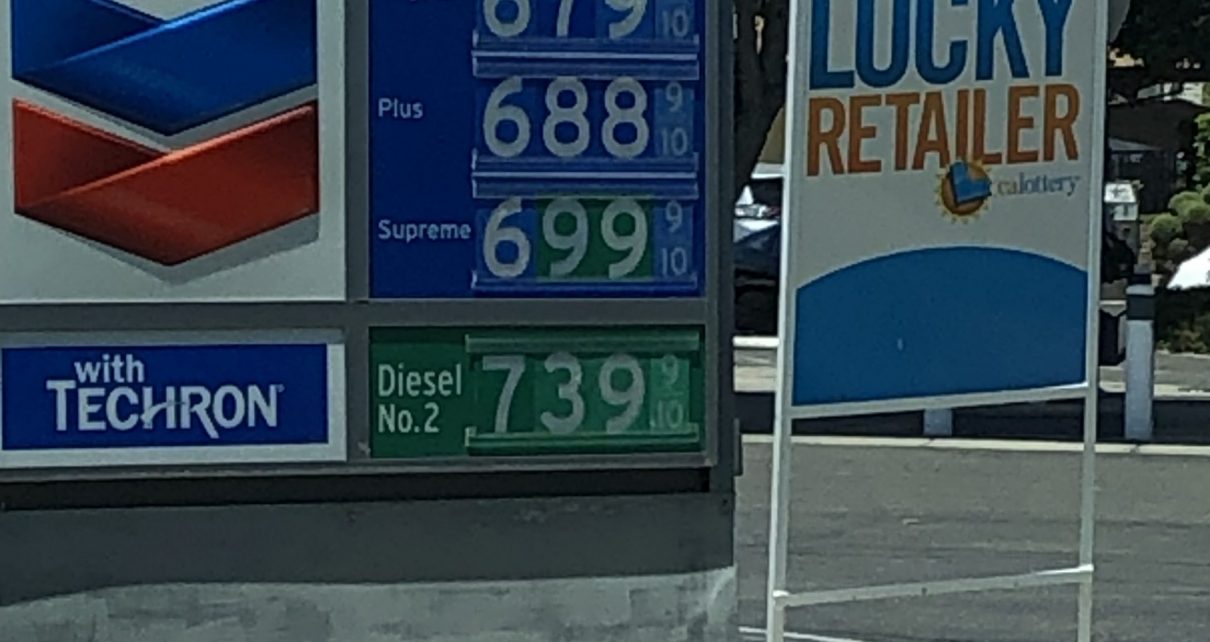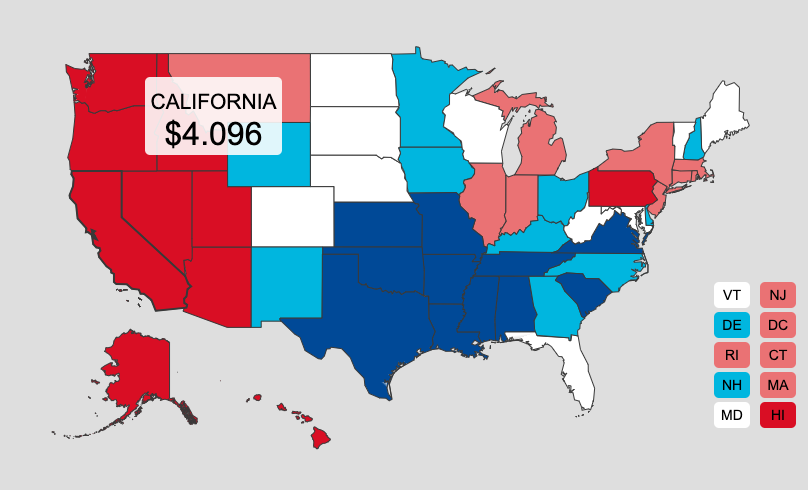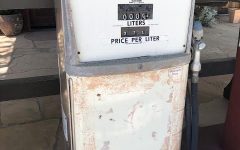
Gas prices, Sacramento, CA, June 13, 2022. (Photo: Katy Grimes for California Globe)
Brace for Impact: California Gas Prices to Increase in 2025
Californian drivers will have to earn an additional $600 to $1,000 a year in pre-tax income to ‘break even’ with 2024 prices
By Michael Mische, November 15, 2024 9:11 am
Policies have consequences. A significant increase in the retail price of gasoline that Californians will pay at the pump is expected for 2025. The projected increase could drive California’s retail gasoline prices to exceed the national average by as much as 62% by late 2025. The increase will contribute to inflation, add to the exceptionally high cost of living in California where only 16% of residents can afford to buy a home, and has a disproportionate and adverse impact on lower income Californians.
On November 8, 2024, the California Air Resources Board (CARB) passed new special blend mandates for California’s Low Carbon Fuel Standard (LCFS). The new standards require that refiners produce, and retail gas stations sell, a new California special blend in 2025. The CARB contends that the new special blend is necessary to achieve carbon and methane emission reduction targets and is consistent with Governor Gavin Newsom’s 2035 mandate to eliminate the sale of internal combustion car sales and 2050 targets. By its own admission, the CARB projected that the new special blend could increase the retail price of gasoline by $0.47 a gallon. However, in hearings, CARB staff noted that “Any estimate of cost from the LCFS regulatory proposal are inherently uncertain because they involve conducting estimates and speculative projections about what may happen in the future.”
When asked by KCRA about the impact of change on retail gasoline prices, the CARB simply stonewalled and did not respond.
A study by the University of Pennsylvania Kleinman Center for Energy Policy contradicts CARB estimates by estimating that retail prices could increase by $0.65 a gallon in 2025, $.85 a gallon in 2030, and $1.50 a gallon in 2035. Early modeling indicates that the regulation could have at least a $0.27 to $0.43 impact on the price of regular fuel. However, depending on the timing and costs incurred by refiners, wholesalers, and retailers to comply with the regulations, the impact on retail prices for regular grade gasoline could be significantly higher, ranging from $0.40 to $0.65 in year one, 2025. Most refineries perform major repairs, upgrades, and maintenance in January and February when demand is lowest and before they are required to transition to the summer seasonal blend, which has higher refining costs and higher retail prices. However, it is unclear at this time as to the cost of compliance, especially if refiners have to incur investments for new technologies, equipment and processes.
Notwithstanding the impact on consumers, the projected increase will have a positive impact on state and local taxes, which are pegged to the retail prices, thus increasing revenues to the governments.
For Californians, the increase in retail prices attributed to the adoption of new special blend standards is not the only regulatory action that will drive retail gasoline prices up in the Golden State. Looming in the background is the October 2024 passing of ABX2-1 requiring California oil refineries to maintain a ready-stock of finished gasoline will create additional costs for producers that must be factored into retail prices. Depending on the costs incurred by refiners for building or acquiring extra storage capacity and the amount of days’ supply that the refiners must maintain the addition to the retail gasoline prices could range between $0.047 to as much as $0.27 per gallon.
Policies have consequences, and within 72 hours of passing ABX2-1, Phillips 66 announced the closing of its Los Angeles refinery. The Phillips 66 LA complex refinery constitutes 8.3% of the total refinery capacity in California. Unless something significant or catastrophic happens, the demand for retail gasoline in California will not fall by 8.3% in 2025, and it is uncertain at this time as to how the loss of Phillips production will be compensated or offset. California has no in-bound pipelines, so crude oil stock and gasoline products must be shipped in via rail, truck or marine vessels…all of which are accretive to the retail price of gasoline and greenhouse emissions.
In consideration of diminishing supply and relatively stable demand, basic economics is that prices will increase. Early USC models indicate that the closure of Phillips 66 and loss of 8.3% of capacity could increase prices at the pump by $0.082 to $0.14 a gallon for regular grade gasoline by year-end 2025. The price increase will be more for premium grade. Additionally, the California excise tax on gasoline, which is indexed to the California Consumer Price Index, is scheduled to automatically increase on July 1, 2025, by roughly $0.011 to $0.018 a gallon from $0.599 to $0.619.8 Collectively, the increases in gasoline prices will have a compounding and inflationary effect throughout California’s supply chains for agricultural production, manufacturing, transportation, food and grocery items, building and construction, utility costs, and other services that are influenced by gasoline consumption.
The recent 2024 legislative and regulatory actions taken by California could result in a cumulative increase in the price of regular grade gasoline for the California consumer of $0.55 to $0.898 a gallon in 2025. For premium grades, the estimated range of increase could be $0.95 to $1.15 a gallon. And that does not include any increases in crude oil prices and the price of wholesale gasoline. Based on the average number of miles driven in California of 12,5249 and California’s average miles per gallon of 31 mpg, California regulatory and legislative actions could conservatively cost the California consumer an extra $222.00 to $449.00 a year for regular grade fuel, more for premium. To compensate for the expected increases in retail gasoline prices, the average Californian driving an internal combustion vehicle will have to earn an additional $600.00 to $1,000.00 a year in pre-tax income to “break even” with 2024 prices, depending on the grade of gas they purchase.
Policies have consequences and Californians must now…Brace for impact.





I heard earlier today a suggestion to put an initiative on the ballot to get rid of CARB
Same thing with the gas taxes and CARB’s latest knuckleheaded move that will cause an additional 65 cent increase
Wondering if this can be done?
Hello Friend,
Yes! is the answer to your question.
But our biggest problem is, this is Communist California!! Run by the Dumocrates of the worst type! Liars, cheaters, and thieves the enemy to American Citizens!! So if we got it to ballet! They will just lie about the outcome? However! We have a new PRESIDENT!! And that means, we now have HOPE!
Here is definition of communism
Communism is a political and economic ideology that aims to create a classless society where the means of production are owned by the public and wealth is shared equally:
Tell me where that is happening in Ca Throwing a label around doesn’t reflect reality..
I’m sure you don’t,,t believe this as Democrats are all communists which is ridiculous
That’s a text book definition of communism. Todays democrats are neo-communists – the religion of takers and the envious and malcontents.
That’s a text book definition of communism. Todays democrats are neo-communists – the religion of takers and the envious and malcontents.
Equal misery, tear down the wealthy and bring up the poor, there is your classless society.
It is happening right now in California, this has been a one party state for 24 years. Ruled by committee.
CARB is a committee, appointed by the ‘party’, PUC is a committee appointed by the party. While the insurance commissioner is elected, his job should be like a bank regulator, making sure that there is enough assets to weather a disaster, not to play Santa Claus.
When the state mandates that energy must be produced by renewable energy and not from market available resources, that’s communism. When the state interferes in the name of some well intended ‘holy’ cause that makes available resources artificially more expensive by regulating and regulating, that’s commie-ism
These democrats are are commies, these are not your Truman Democrats, or your Kennedy Democrats from our past.
H.L. Mencken wrote ” Democracy is the theory that the common people know what they want, and deserve to get it good and HARD”.
People are stupid, california only has to look in the mirror, voting for things like Prop 103 (cheaper insurance rates) Prop 1A (high speed rail) Props 47-57 (decriminalize crime). .
Commies only destroy what was built before them, by using envy, envy and jealousy (7 deadly sins)
It will take YEARS to build back trust in this state, where investment will come back if ever.
You commies will sit back and criticize the rebuilding of what you broke is not going fast enough thereby insinuating you could do better.
Well JSK, you do seem like the type to call the 45th & 47th President “Hitler”, so I don’t think the details of words matter much to you.
I’m late to the reply party, but I agree
True that. A couple of years ago we put a prop on the ballot to repeat a large gas tax. The commiecrats in Sacradimento changed the title from something like “repeal the gas tax” to “reduce monies for transportation improvements “ (very paraphrased but the meaning is accurate). They even suddenly started road projects at election time with signs saying “your gas taxes at work improvements”, which suddenly stopped after the election where that proposition was defeated. Texas and Florida look mighty good to me now. Hate to leave California but maybe it’s time to move to Free America.
I’d like to know how to get Gavin Newsom out of My State. I see he is a very big problem and he is at the root of the issues with my state. I’ve had enough.
yes agree!!! Neudescum should go but he won’t. I heard he will run to be Senator that has no term limits so he can stay in power forever.
Can you imagin Gruesom as POTUS?
With new tariff starting next year prices, everything will go up. Because they have to increased prices to pay for tariff cost.
Who counts the votes? No chain of custody for drop box ballots? Who writes the descriptions for ballot initiatives?
PLEASE……
Yes… please!! I don’t know if an initiative could legally get rid of CARB but I’m willing to try.
One would think we could at least gut this lunatic agency roll back their cruel. anti working and middle class dictates. And initiative should include the provision that any state regulatory agency raising taxes or fees on the people would have to be approved by both houses of the legislature and the governor first.
This would put these Dem legislators finally on the record and directly responsible to the voters would could then act accordingly at the polls. Right now they secretly approve these ridiculous mandates but having a rogue agency do their dirty work washes their hands of responsibility for the onerous regulations directly. This needs to stop. Tax revolt time people!! We had enough.
What do you think that will do to air quality? l like being able to breathe clean air. Any increase in price because of emissions standards is on the gas companies who make billions in profit every quarter. The least they can do is improve air quality without raising prices.
get rid of Gavin
Yes, or at least make them advisory anf force the legislature to vote on their crazy recommendations
Hello Friend,
Yes! is the answer to your question.
But our biggest problem is, this is Communist California!! Run by the Dumocrates of the worst type! Liars, cheaters, and thieves the enemy to American Citizens!! So if we got it to ballet! They will just lie about the outcome? However! We have a new PRESIDENT!! And that means, we now have HOPE!
I am soooo sick of gas prices and the liars associated with gas prices! #1 Just get rid of CARB completely!!! #2 We need to rid ourselves of Governor Gaven ” The Crook and Liar” Newsom and the SCUM he stands for! We the people are hip to all the Dumo lies and the Dumocrates behind all the lies! Open your eyes fellow Americans!!! As we need to drain all of the Scum from all of the Dumocrat built Swamps in California and the whole country! Our fellow Americans in the South are still suffering with little to NO help from this government! All because our tax dollars went to illegals, instead of our American Tax paying Citizens that need it right NOW!!!! These Dumocrates need to be held responsible for the missing American tax dollars, our fellow American tax paying brothers and sisters need so badly!! Thank GOD for Donald Trump!!!!!
Yes we need to get rid of this dirt bag crook Newsome.We need to stand up to this destroyer of state and people now.He needs to be exposed to the nation before he takes a run for the white house.
Hey buddy cut down on that green and white stuff. If you dislike California so much why dont you move to one of those loser red states? Noone is holding you gere at gun point, good riddance.
Carb should be investigated and eliminated for fraud as well as put in prison with all parties involved including ca governor,not only do they steal lie and manipulate laws in there favors to get more money from ca DMV fees ,CA smogs fees and all ca performance parts distributers but make laws restrictions regarding using other alternatives fuel such as e85 and other fuels.
The whole thing about raising gas prices is Fucking Stupid ! So are the ones behind the cause !
who empowered these clowns?
please wake up California!
Answer: Democrats.
we have a gubnetorial recall available to us and if we don’t use it, we deserve these prices.
Gavin is a Democrat. stupid Democrats
Good job Gavin, you became a millionaire.
This article is so biased it’s a lie. for one thing Philips selling their refinery was already in the works but you’re lying by saying it was connected to the inventory change. They were planning this long before the announcement and they support the inventory change.
You call CARB not answering your questions about impact on retail prices stonewalling but the reality is from your own article you’re asking questions they already answered. The made a prediction of what the impact on retail prices might be. So why ask again? They’re estimates. They aren’t setting the price or charging a retail tax. it will likely effect prices but all they can do is estimate.
And no refiners et al do not need to necessarily reflect costs in consumer prices. Prices are a function of supply and demand not primarily cost. businesses price to maximize profits subject to price elasticity of demand. sometimes you can make more profits by lowering prices. Sometimes you make more by raising prices. You have to cover costs to remain in business but there is also reducing costs in other areas and reducing profits that can happen.
Site your source for the Phillips 66/Unocal closure, please “John”???
Bet you cannot….
this has to be repealed…outrageously unfair.
Daddy trump please help!!! gas too expensive please daddy trump white BELLYRAT NEVER NEVER THE LESS!help bring the gas price down!!!! AIN’T HAPPENING BECAUSE GAS PRICE IS CONTROLLED BY STATE NOT FEDERAL GOVERNMENT, SO GOOD LUCK IN TRUMP BRING THE PRICE DOWN, VIVA MEXICO CABRONES,
We’ll have to build barns to store the straw so we can feed our horses that’ll pull us around in buggies
there will be gas shortages with no gas available at any price. I experienced this in the 70’s. when it happens it will be miserable and very disruptive.
I seriously don’t want to live in this state anymore. I’m barely making it by as it is and we have politicians that truly believe we will save the environment if only the poors can’t afford to drive their vehicles. Or better yet, if only the poors can’t afford vehicles, we will save the planet. I can’t wait to move out of this state.
This is only one of many subjects where CA is over taxing it’s citizens. There’s no concern for any costs. This is the liberal wealthy side wagging the dog and conservatives have a tail too.
The lower of either party always get the dredges but democrats are too idealistic for capitalists that tune their domains.
The two really need to come together for the people prosper.
This constant extreme ebb and flow popularity only prospers those that can survive the turmoil, the wealthy, and they run all the shows.
If prices do go up that much the blame is fully on oil companies not the agency trying to cut pollution and give us better air quality.
Have to respectfully disagree, oil companies exist to make a profit. If you owned a business and regulations increased your operating expense, you might consider raising prices to cover the profit loss. Refineries employ thousands of Californians with high paying union jobs. Not to mention the supporting contractors that work in refineries. If an oil company is not turning a profit due to California regulations, they will simply stop doing business in California or import refined product from Asia. Importing finished product will add to the price at the pump as well as eliminating high paying blue-collar jobs in the state.
Have to respectfully disagree, oil companies exist to make a profit. If you owned a business and regulations increased your operating expense, you might consider raising prices to cover the profit loss. Refineries employ thousands of Californians with high paying union jobs. Not to mention the supporting contractors that work in refineries. If an oil company is not turning a profit due to California regulations, they will simply stop doing business in California or import refined product from Asia. Importing finished product will add to the price at the pump as well as eliminating high paying blue-collar jobs in the state.
Have to respectfully disagree, oil companies exist to make a profit. If you owned a business and regulations increased your operating expense, you might consider raising prices to cover the profit loss. Refineries employ thousands of Californians with high paying union jobs. Not to mention the supporting contractors that work in refineries. If an oil company is not turning a profit due to California regulations, they will simply stop doing business in California or import refined product from Asia. Importing finished product will add to the price at the pump as well as eliminating high paying blue-collar jobs in the state.
I don’t live in CA so I cannot share your pain. Before the election CA residents could supplement their income by stealing up to $950 a day. The Govornor and Democratic legislature made this almost legal. But this has ended. Maybe CA voters must consider having at least two parties in power to have positive change. And require voter ID. Otherwise your suffering will get worse.
WTF are you guys talking about the gas has been increased the whole time dumasscrates were in office and still increasing
Newsom is an asshle. S.O.B. C.A R.B. is nothing but a money scam,Im not buying an EV. they can suck it.!!!!
Get rid of the politicians in California especially the worst governor in the nation!!! The scum needs to go!!
Gavin Newson pls get out of the California , your making the California people mesirable
Looks like this has now gone into effect here in California as gas has jumped about 75 cents in the last two weeks to about 5 bucks a gallon. Of course they will now say it’s because of Trumps proposed tariffs driving up the cost when this has been on the books since last year. We are sponges in California is getting squeezed now a little more.
Policies only get a proper analysis when posed against others. Where and what other states, blue states have gas ⛽️ refinement rules anywhere close to CA?
Why isn’t CA excoriating others, anyone into a similar practice if it’s so important?
How come those with solar in CA that are fairly energy neutral have seen their rates SKYROCKET over the past 5 years?
The answers are pretty clear. These “adjustments” are just ways to drive more profit to energy companies, full stop. Instead of robbing citizens, give enormous incentives to solar and electric cars and the carbon rates would reduce IMMEDIATELY.
But no, you just rob them after they’ve made the previous green investments.